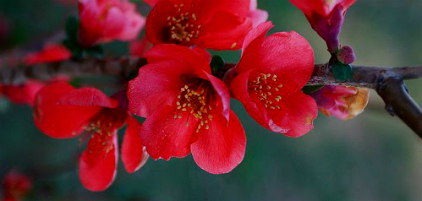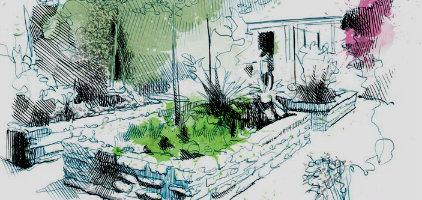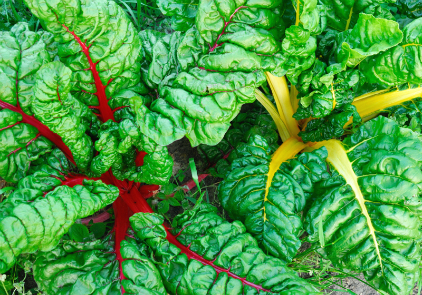
bringing nature, nurseries and gardeners together Jan 31, 2019
|
|
Nursery notes: The Austin Garden now has its own official website. You can visit it to read previous issues, share sign-up links, and you can also make donations to help fund this news- letter. Thank you for your support ; - )
Over at the Natural Gardener a free class called 'The Perma- culture Paradigm,' with Woody Welch happens this Saturday at 10 a.m. Next Saturday. also at 10 a.m. 'Antique Roses: the Ultimate Landscape Plant.' TNG events.
If you are looking for antique roses or houseplants, Barton Springs Nursery recieved some huge shipments this week. Also for fans of off-beat natives, they have a couple of Lord Byron viburnums: 3 gal. $30. 15 gal. $80. (They're hybrids of Walter's and rusty black haw viburnums.)
TreeFolks needs volunteers to help plant 1,250 seedlings in Pease Park at 9 a.m. on Sat. Feb 9. Ready, Set, Plant! ❦

The magic of flowering quince: on our street we were blessed to witness the Japanese delicacy of these scarlet beauties 2 weeks ago. . . in the dead of winter. Chaenomeles superba, a thorny deciduous shrub, is drought hardy, does well in full to partial sun, and is guaranteed to lift a gardener's spirits in the winter months. (Barton Springs Nursery has 3 gal. TX scarlet quince: $25.) Fine Gardening ❦

Eight secrets of landscape design: enter the world of golden ratios, regulating lines and 'significant enclosure' to help you with decisions for your designs in 2019. A well-written, user-friendly guide by Rob Steiner. Garden Design ❦
The Austin Garden is sponsored by Hays Free Press 
Central Texas Gardener: On tour, discover how nature inspired a new direction for artist Valerie Fowler. Daphne analyzes iron defic- iency on a loquat, and a fire marshall offers advice about designing gardens which minimize the risk of fire. Sat. 4 p.m., Sun. 9 a.m. KLRU ❦
 February in the Garden
by Chris Winslow
With the arrival of February tomorrow, we enter one of the most exciting gardening months of the year. The days are getting longer, and the last average freeze and frost dates are approaching. Also the days are cooler and it is more com-fortable to work outside.
1. Clean up the landscape. Cut back perennials and apply a mulch-compost blend. Add green sand and sulfur to plants their soil to be a little more on the acidic side. Check leaves for signs of iron deficiency. Light green leaves with darker veins indicate a lack of iron. Green sand and sulfur will help to cure this deficiency.
2. Plant fruit trees. Peaches, pears, persimmons, plums, apricots, pomegranates, and apples do well in this area. For those with limited space, or with an appetite for novelty, try a ‘four-in-one’ grafted apple or pear. They have four different varieties grafted on the same tree. For those without a yard, you might try a dwarf peach. They’re easy to grow in a pot or whisky barrel.
3. Plant vegetables in kitchen garden. Broccoli, Brussels sprouts, cauliflower, cabbage, pod peas (sugar snaps), Swiss chard (see photo above), carrots, lettuce, and asparagus crowns. Also onions, such as the white Texas Supersweet called Contessa.
4. Plant winter hardy herbs. Thyme, oregano, Italian and curled parsley, rosemary, winter and summer savory, garden sage, and chives. Herbs like to have at least a half a day’s sun in a well-drained location.
5. Plant flowers in the garden. Calendula, pansies, stock, cyclamen, violas, dianthus, bluebonnets, nasturtium, flowering cabbage and kale, and larkspur. For a great show, plant snapdragons now for April and May color.
6. Plant a rose. Besides some good old standbys like the peace rose, Mr. Lincoln, climbing Don Juan, and Blasé, there are some interesting newcomers to look for, such as the Knock Out series, Home Run and Belinda’s Dream. But let’s not forget our charming antique roses as well. Antiques are disease resistant, hardy, and can shower our landscapes with very beautiful, showy flowers.
7. Prune your roses. A mid-month activity. A word of caution: make sure you know what kind of rose you have before you begin to cut them back. Most shrub roses bloom on new wood, so a pruning will help to force new growth and blooms. Climbing roses bloom on old wood, so this means a pruning back of climbers will remove all the flowers before they have a chance to bloom. Please give me a call if you have any questions about this. I have some weighty rose books that have most of the answers.
8. Control lawn weeds. Spread a pre-emergent weed killer over the yard and water it in. We recommend corn gluten. This is an effective organic pre- emergent that will not poison waterways and aquifers. If you spread it over the lawn, it will control those spring and summer weeds before they have a chance to germinate. You can safely use it in the garden or in flowerbeds.
9. Maintain garden tools. Repair and maintain garden tools. Change the oil on the lawnmower, and have the blades sharpened.
10. Garden plan. Put something down in a book, a diary, or even on a scrap of paper that you tape to the wall. This will help you plan your weekend activities and get your plants in the ground at the correct time of the year.
Wouldn’t you know it? February is the shortest month with so much to do! Happy gardening everyone! ❦
|
 It's About Thyme Legacy Publications.
Contact newsletter editor Darrel Mayers with any ideas for articles or interesting links at internationalrain@yahoo.com (hitting 'reply' to this email won't work) |
|
|